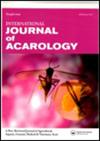Transcriptomics and proteomic-based study of the acaricidal mechanism of paeonol against Aleuroglyphus ovatus
IF 1
3区 农林科学
Q3 ENTOMOLOGY
引用次数: 0
Abstract
Aleuroglyphus ovatus, a common mite harming stored grain, poses a threat to human health. Paeonol is the main component isolated from peony roots and exhibits various medicinal values. In our previous study, we found that paeonol shows strong acaricidal activity. In the present study, the acaricidal mechanism of paeonol against A. ovatus was uncovered through RNA-seq transcriptomics and TMT proteomics. According to the transcriptomics results, paeonol treatment noticeably up-/downregulated genes associated with “oxidoreductase activity” (peptidase activity, ATPase activity, and hydrolase activity). As shown by proteomic analysis, concordant changes were identified in proteins linked with hydrolase activity, serine-type peptidase activity, antioxidant activity, and oxidoreductase activity. Paeonol target proteins were FMO, ACAD8, GPX, CTSL, and PRSS1, as determined by transcriptomics-proteomics correlation analysis. We propose that paeonol may play an acaricidal role by interfering with enzyme activities in A. ovatus, especially serine-type peptidase, thereby causing an imbalance in amino acid ratios and eventually leading to the death of A. ovatus. However, the specific mechanism of action needs to be further studied. In addition, we verified the key enzymes at the transcriptional level.基于转录组学和蛋白质组学的丹皮酚对卵蚜杀螨机制研究
卵蚜螨是危害储粮的一种常见螨类,对人类健康构成严重威胁。丹皮酚是从牡丹根中分离得到的主要成分,具有多种药用价值。在我们之前的研究中,我们发现丹皮酚具有很强的杀螨活性。本研究通过RNA-seq转录组学和TMT蛋白质组学方法,揭示了丹皮酚对卵蚜的杀螨机制。根据转录组学结果,丹皮酚处理显著上调/下调与“氧化还原酶活性”(肽酶活性、atp酶活性和水解酶活性)相关的基因。蛋白质组学分析显示,与水解酶活性、丝氨酸型肽酶活性、抗氧化活性和氧化还原酶活性相关的蛋白质发生了一致的变化。通过转录组学-蛋白质组学相关分析确定丹皮酚靶蛋白为FMO、ACAD8、GPX、CTSL和PRSS1。我们认为丹皮酚可能通过干扰卵泡刺槐体内的酶活性,尤其是丝氨酸型肽酶的活性,从而导致卵泡刺槐体内氨基酸比例失衡,最终导致其死亡。但具体的作用机制还有待进一步研究。此外,我们在转录水平上验证了关键酶。
本文章由计算机程序翻译,如有差异,请以英文原文为准。
求助全文
约1分钟内获得全文
求助全文
来源期刊
CiteScore
2.20
自引率
9.10%
发文量
60
审稿时长
6-12 weeks
期刊介绍:
The International Journal of Acarology has a global readership and publishes original research and review papers on a wide variety of acarological subjects including:
• mite and tick behavior
• biochemistry
• biology
• control
• ecology
• evolution
• morphology
• physiology
• systematics
• taxonomy (single species descriptions are discouraged unless accompanied by additional new information on ecology, biology, systematics, etc.)
All submitted manuscripts are subject to initial appraisal by the Editor. If the English is not of a quality suitable for reviewers, the manuscript will be returned. If found suitable for further consideration, it will be submitted to peer review by independent, anonymous expert referees. All peer review is single blind.

 求助内容:
求助内容: 应助结果提醒方式:
应助结果提醒方式:


